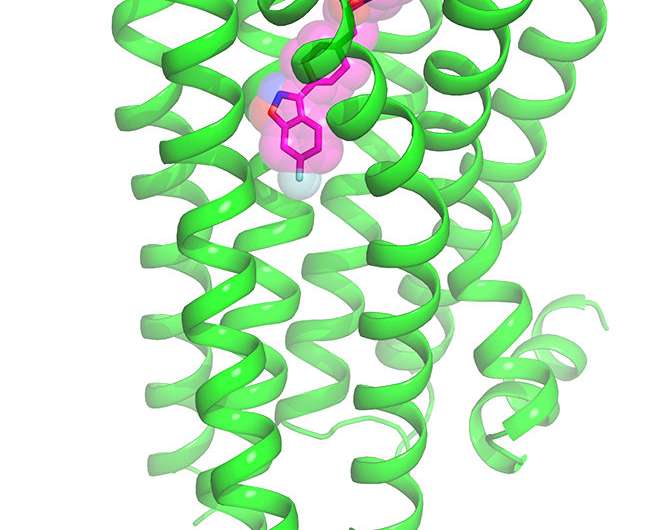Molecular secrets revealed: Antipsychotic docked in its receptor

Antipsychotic drugs—which transformed mental health care following their chance discovery in the mid-20th Century—may finally be poised for a long-overdue makeover incorporating structure-based design. Scientists funded by the National Institutes of Health have achieved a landmark of psychiatric neuropharmacology: deciphering the molecular structure of a widely prescribed antipsychotic docked in its key receptor. They are hopeful that this discovery may hold secrets to designing better treatments for schizophrenia, bipolar disorder, and other mental illnesses.
"For the first time, we can understand precisely how atypical antipsychotic drugs bind to their primary molecular target in the human brain," explained Dr. Laurie Nadler, chief of the neuropharmacology program at the National Institute of Mental Health (NIMH), which co-funded the study along with the National Institute of General Medical Sciences and the National Cancer Institute. "This discovery opens the way for the rational design of a new generation of antipsychotic drugs, hopefully with more desirable effects and fewer side effects."
Researchers Bryan Roth, M.D., Ph.D., of the University of North Carolina (UNC) Chapel Hill, Brian Shoichet, Ph.D., of the University of California San Francisco, and colleagues, report on their discovery of the crystal structure of the antipsychotic risperidone docked in the D2 dopamine receptor in the journal Nature.
Before becoming a laboratory scientist, psychiatrist Roth experienced first-hand the limitations of existing antipsychotics while treating patients with schizophrenia. The medications excel at quelling hallucinations and delusions, yet largely fail to address schizophrenia's debilitating cognitive and social impairments, while increasing risk for movement disorders, weight gain, and other metabolic and cardiovascular side effects.
Many of these side effects result from existing antipsychotics' interaction with several other types of receptors in addition to the D2 receptor. Consequently, an in-depth understanding of the molecular workings holds hope for designing agents with just the desired properties that would act more precisely. For example, Roth and colleagues in 2016 reported developing such a designer pain-reliever that works via a key opioid receptor, but in a way that avoids morphine's side effects. Earlier this month, they similarly revealed a designer opioid compound that selectively acts through a different opioid receptor, that has a more benign side-effect profile.
The new molecular pictures show that risperidone binds to the D2 receptor in an unexpected way that could not be predicted based on previous structures of similar dopamine receptors. Notably, the D2 receptor harbors an unexpectedly deep "pocket" that the researchers think could be targeted to design more selective drugs with fewer side effects.
More information: Structure of the D2 dopamine receptor bound to the atypical antipsychotic drug risperidone. Wang S, Che T, Levit A, Shoichet BK, Wacker D, Roth BL. Nature. 2018 Jan 24, DOI: 10.1038/nature25758
Journal information: Nature
Provided by National Institutes of Health




















